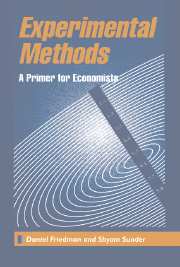Book contents
- Frontmatter
- Contents
- List of figures and tables
- Preface
- Acknowledgments
- EXPERIMENTAL METHODS
- 1 Introduction
- 2 Principles of economics experiments
- 3 Experimental design
- 4 Human Subjects
- 5 Laboratory facilities
- 6 Conducting an experiment
- 7 Data analysis
- 8 Reporting your results
- 9 The emergence of experimental economics
- Appendixes: Supplemental materials
- Glossary
- References
- Index
3 - Experimental design
Published online by Cambridge University Press: 05 June 2012
- Frontmatter
- Contents
- List of figures and tables
- Preface
- Acknowledgments
- EXPERIMENTAL METHODS
- 1 Introduction
- 2 Principles of economics experiments
- 3 Experimental design
- 4 Human Subjects
- 5 Laboratory facilities
- 6 Conducting an experiment
- 7 Data analysis
- 8 Reporting your results
- 9 The emergence of experimental economics
- Appendixes: Supplemental materials
- Glossary
- References
- Index
Summary
How does the number of buyers and sellers affect market efficiency? Do consumers prefer the “new improved” product or the “classic” version? Whether your purposes are scientific or commercial, you probably are interested in the effects of only a few variables, the focus variables. Usually you must also keep track of several other variables of little or no direct interest, the nuisance variables, because they may affect your results.
Which variables are focus and which are nuisance in your experiment depends on your purpose. The number of buyers is a focus variable in some oligopoly experiments, but the same variable is a nuisance in experiments testing consumer response to new products.
This chapter will explain how to design experiments that sharpen the effects of focus variables and minimize blurring due to nuisance variables. It will also explain how to design experiments that allow you to disentangle the effects of different variables, that is, how to avoid confounding the effects of two or more variables.
The first two sections introduce control and randomization, the basic ingredients of proper experimental design. Sections 3.3 and 3.4 elaborate on these ingredients and discuss specific designs. Distilled practical advice appears in the next section, and the last section illustrates the main ideas while reviewing some “test-bed” market experiments.
A word of warning before we begin. This chapter contains technical jargon. We have tried to follow the most common practices, but the literature is not entirely consistent in how words are used.
- Type
- Chapter
- Information
- Experimental MethodsA Primer for Economists, pp. 21 - 37Publisher: Cambridge University PressPrint publication year: 1994



